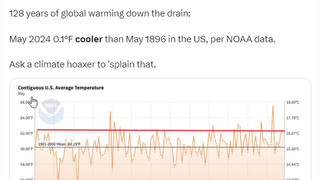
Does the ocean being colder along the seafloor prove that Earth's core is frozen, as a video on TikTok suggested? No, that's not true: Scientific literature shows that the Earth's interior is indeed hot, with some estimates suggesting it is comparable to the surface of the Sun. While the Earth's interior is hot, a deep-sea scientist told Lead Stories that the temperature of the seafloor is influenced by a combination of factors, including the conduction of heat, circulation, and characteristics of water, and volcanic activity, such as seafloor spreading and localized hydrothermal vents.
The claim originated in a video shared to TikTok on May 25, 2024 (archived here), in which an unidentified person states, "If the center of the Earth is hot, why is the bottom of the ocean cold?" A caption that accompanied the video read:
#centreoftheearth #earthscore #earth #core #volcano #iceage #dinosaur #extinction #ocean #sea #oceandepths #mystery #question #questions #cold #hot #lava #magma #uk #unitedkingdom #british #brtian #england #english #usa #think
The person in the video states that "it doesn't make sense" that the colder the water is, the closer it is to the center of the Earth (i.e., the bottom of the ocean).
Below is how the post appeared on TikTok at the time of this publication:
(Source: TikTok screengrab taken Fri June 7 09:46:09 2024 UTC)
Earth's core is indeed hot
Earth's core is composed of a solid inner core surrounded by an outer shell of liquid mostly formed by molten iron and nickel, according to the California Academy of Sciences (archived here). The inner core temperature ranges between 4,000 and 9,000 degrees Fahrenheit, or just below the temperature that NASA predicts (archived here) to be at the sun's surface.
However, while the Earth's interior is indeed hot, the temperature of the seafloor is influenced by a combination of factors. Moronke Harris (archived here), a microbiologist and deep-sea scientist working with the Ocean Exploration Trust and the University of Victoria in Canada, told Lead Stories in an email on June 9, 2024, that these influences include the conduction of heat, circulation, and characteristics of water, as well as volcanic activity, such as seafloor spreading and localized hydrothermal vents.
Conduction of heat
Largely composed of dense basalt rock averaging between three and six miles thick, Earth's crust serves as an insulating layer between the core and ocean and acts as a barrier to transferring heat.
"The seafloor itself sits on the crust, the outermost layer of our Earth. Oceanic crust, in particular," wrote Harris. "This is too great of a distance for the heat of the upper mantle layer, which is [about 400 degrees Fahrenheit] at its boundary with the crust, to penetrate to the surface."
Water circulation
Ocean temperature is also influenced by the movement of water driven by currents and tides, playing a role in heat distribution.
For example, cold water is denser and heavier than warm water, meaning it weighs more in the same volume than its warmer counterpart. Because it is heavier, cold water sinks toward the seafloor, replacing warm water, which circulates upward.
"Heat in the ocean is sourced from sunlight, which dissipates as one descends from the surface to the seafloor. Cold water is denser than warm water, therefore lower-temperature water sinks below the less dense warmer water near the surface in ocean basins," Harris told Lead Stories.
Combined with wind-driven currents at the surface, this process creates a complex pattern of ocean circulation known as the "global conveyor belt," according to the National Oceanic and Atmospheric Administration (archived here). Because of these influences, the agency writes (archived here) that the "temperature of ocean water varies by location -- both in terms of latitude and depth, due to variations in solar radiation and the physical properties of water."
Scripps Institution of Oceanography (archived here) reports that the global average seafloor temperature at 6,560 feet is 36.5 degrees Fahrenheit, and some locations are less than 33.8 degrees Fahrenheit. By comparison, water freezes at 32 degrees Fahrenheit.
Volcanic activity
Volcanic activity also influences the temperature of the seafloor, which can be quite hot in some locations.
For one, seafloor spreading at mid-ocean ridges is caused by tectonic plates moving apart, allowing magma to rise to the seafloor's surface and create new oceanic crust. This releases heat near the ocean floor, increasing the temperature near the release at some points. However, that heat is dissipated by surrounding seawater.
Underwater volcanoes at these spreading areas can also create submarine hot springs known as hydrothermal vents (archived here), or fissures in the Earth's crust that allow heat to be released.
"These features are formed where the tectonic plates interact, diverging, subducting, and colliding, to create crustal openings where Earth's hot interior superheats seawater that trickles down through the crust (hydrothermal vents) or melts crustal material forming rising magma (volcanoes)," wrote Harris.
These localized areas also release hot water due to the interaction between seawater and heat released from the Earth's crust. Research has shown that some sites have reached as many as 401 degrees Celsius, or more than 700 degrees Fahrenheit (archived here).
However, the impact of these volcanic features on water temperature at a global scale is relatively small.
"Though fissures in the earth's crust allow some of the mantle's heat to escape, and these locations are found dotted across the seafloor worldwide, the small total area covered by these features in comparison to the total area of the seafloor (covering ~70% of our earth's surface), and the specific heat capacity of water stifle the spread of higher temperature water," explained Harris, adding that:
Water has the highest specific heat capacity (a material's ability to retain heat and the amount of energy needed to change its temperature/the rate at which it will heat up or cool) of any liquid, meaning it takes more energy to raise its temperature than other substances.
Put simply, water heats and cools slowly. This does not allow the heat emitted by hydrothermal vents and seafloor volcanoes to travel very far. This heat is instead concentrated near its source. Temperature measurements will drop from 300 Celsius+ [500+ Fahrenheit] in hydrothermal plumes to just 2-4 Celsius [35-39 Fahrenheit] in ambient seawater a horizontal distance of 1 meter [3.3 feet] away.
Additional fact checks
Other Lead Stories fact checks on science-related claims can be read here.


















